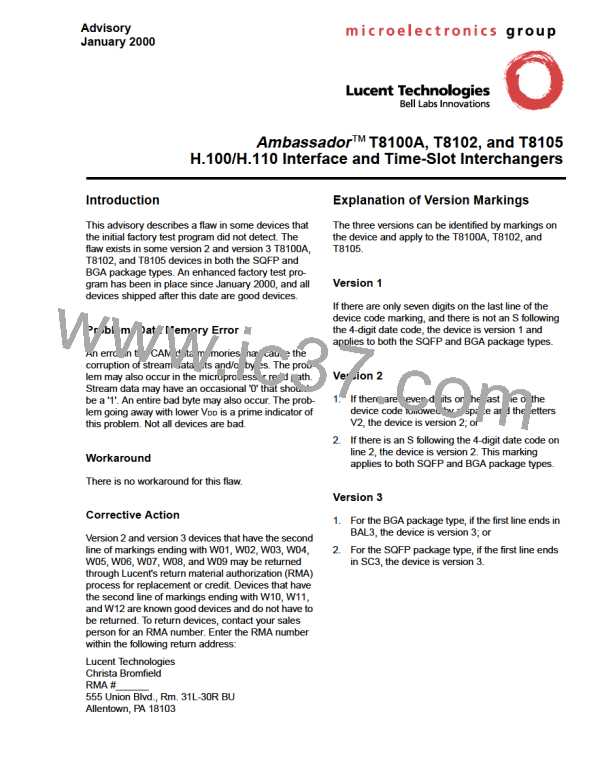Ambassador T8100A, T8102, and T8105
H.100/H.110 Interfaces and Time-Slot Interchangers
Advance Data Sheet
November 1999
Minimum Delay This is the most common type of
switching, but has a shorter range than
constant delay, and the user must be
aware of exceptions caused by interac-
tions between the device's internal
pipeline and the dual buffering. The to
time slot is at least three time slots
after the from time slot, but no more
than 128 time slots after the from time
slot. Exceptions exist at TS∆s of +1,
+2, –126, and –127.
Appendix B. Minimum Delay and
Constant Delay Connections (continued)
B.2 Delay Type Definitions
Constant Delay This is a well-defined, predictable, and
linear region of latency in which the to
time slot is at least 128 time slots after
the from time slot, but no more than
256 time slots after the from time slot.
Mathematically, constant delay latency is described as
follows*, with L denoting latency, and FME set to the
value indicated:
Forward Connections, FME = 0: L = TS∆ (3 ≤ TS∆ ≤
127)
Reverse Connections, FME = 1: L = 128 + TS∆ (–125 ≤
TS∆ ≤ 0)
Forward Connections, FME = 1: L = 128 + TS∆ (0 ≤
TS∆ ≤ 127)
Example:
Using the same switching from the
example above, TS(37) to TS(1), the
delta is –36, so FME is set to 1 to effect
the minimum delay (setting to 0 effects
constant delay), and the resulting
latency is 128 – 36 = 92 time slots. The
relative positions of the end time slots
are the same in both minimum and con-
stant delay (i.e., they both switch to
TS[1]), but the actual data is delayed by
an additional frame in the constant delay
case.
Reverse Connections, FME = 0: L = 256 + TS∆ (–127 ≤
TS∆ ≤ 0)
Example:
Switching from TS(37) to TS(1) as a con-
stant delay, the delta is –36, so FME is
set to 0 and the resulting latency is 256 –
36 = 220 time slots. Thus, the connec-
tion will be made from TS(37) of
Frame(n) to TS(1) of Frame(n + 2).
Simple
Summary:
Use constant delay for latencies of 128
to 256 time slots, set FME = 1 for forward
connections, set FME = 0 for reverse
connections.
Simple
Summary:
Use minimum delay for latencies of 3 to
128 time slots, set FME = 0 for forward
connections, set FME = 1 for reverse
connections.
* Since TS∆ = TS(to) – TS(from), the user can modify the equations
to solve for either TS(to) or TS(from).
127
255
0
128
RESULTING LATENCY
(TIME SLOTS)
256
–127
129
5-6223 (F)
Figure 39. Constant Delay Connections, CON[1:0] = 0X
104
Lucent Technologies Inc.

 AGERE [ AGERE SYSTEMS ]
AGERE [ AGERE SYSTEMS ]